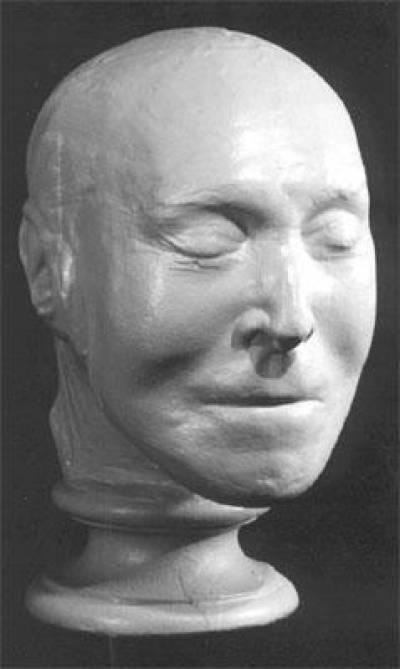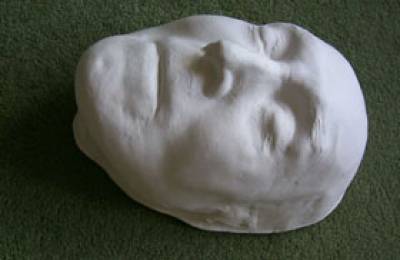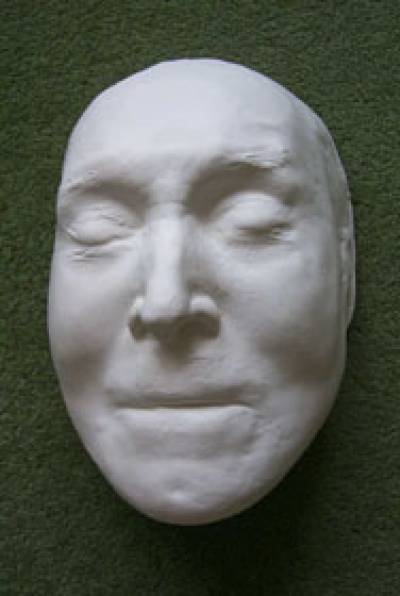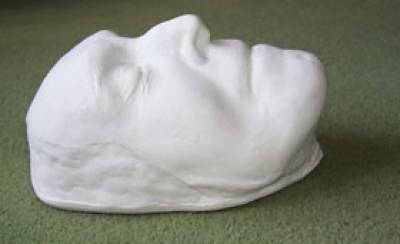|
A mask of Bentham, now in the possession of the William Ramsay Henderson Trust and kept at the Department of Anatomy at the University of Edinburgh, was originally acquired by the Phrenological Society of Edinburgh in the 1830s. The Society was founded in February 1820, and published a journal of its proceedings which first appeared in 1824. Until 1886 the Society displayed the masks they owned in their Museum, the final location of which was in Chambers Street, Edinburgh. A note by George Combe (1788-1858), one of the founders of the Society, in the Phrenological Journal, and Magazine of Moral Science for 1838 records that Bentham's mask was by then in the Society's collection: 'We have a cast of Bentham's head, in which the knowing organs are large, and the reflecting organs only full. Love of Approbation is enormous, and concentrativeness only full.' Until recently it was presumed that the mask was made after Bentham's death, sometime between the lecture over Bentham's body on 8 June 1832 and its dissection on 11 June 1832 at the Webb Street School of Anatomy and Medicine, London. But a question mark has remained over why Thomas Southwood Smith (1788-1861) did not refer to the death mask when creating a head for Bentham's auto-icon. Following the dissection, Bentham's body was sent to Southwood Smith for auto-iconization, and he tried to preserve Bentham's head by placing it under an air pump over sulphuric acid, but the experiment failed. He then asked Jacques Talrich, a French artist who made models for medical schools and anatomical museums, to model a wax head of Bentham, with the help of the bust of Bentham by David and the portrait by Pickersgill both in the possession of John Bowring, and his own copy of one of Bentham's mourning rings. It seems very likely that had a death mask of Bentham been made at the Webb Street School of Anatomy Southwood Smith would have also made this available to Talrich. |
 |
| © William Ramsay Henderson Trust | |
|
It is now thought likely that the mask was in fact made in Bentham's lifetime. John Flowerdew Colls, Bentham's amanuensis, records in his journal for 12 September 1823: 'Mr Alcock and nephew to dinner-took a mask of JB in plaster of paris.' Thomas Alcock (1784-1833) a surgeon, who from 1813 to 1828 was surgeon to St James's Workhouse in London, had visited Bentham earlier in August of the same year, when he had left some of his medical pamphlets for Bentham to read. Notes from Bentham's memorandum book and Colls's journal indicate that Bentham's interest in Alcock centred about the subject of his head, and their mutual interest in education. To make this life mask Bentham would have had to submit to a rather unpleasant process, which involved moistening the hair and face with a sweet oil, inserting quills in the nostrils, and reclining at an angle of 35°, while the face was covered with plaster, and the back of the head was then pressed into a flat dish also containing plaster. In this state the subject rested until the plaster was set. No further evidence of the existence of this mask has yet been found, so it is therefore not possible at present to confirm beyond doubt whether the mask in Edinburgh is the one made by Thomas Alcock. Another life mask was made of Bentham's head by the sculptor, Turnerelli, as a record and aid to his work on Bentham's bust in 1808, but it is unlikely that a mask made as part of an artistic project would have survived. The mask belonging to the William Ramsay Henderson Trust was exhibited in Death Masks and Life Masks of the Famous and Infamous in Edinburgh in 1988, and was recently seen in London in Spectacular Bodies: The Art and Science of the Human Body from Leonardo to Now, an exhibition organized by the Hayward Gallery, October 2000-January 2001. The International Society for Utilitarian Studies (ISUS), administered from UCL, has recently purchased a copy of a second-generation casting of the mask from the Hutton Collection in America. This Collection was started in the 1860s by the American scholar and author, Laurence Hutton (1843-1904), who some time in the 1890s acquired a copy of Bentham's mask. The Collection was later bequeathed to the University of Princeton, New Jersey, where it remains today. The mask is at present displayed in the Student Common Room, Laws Department, Bentham House, UCL. |
Second Generation Casting of Bentham's Life or Death Mask
 |
 |
 |
 Close
Close

